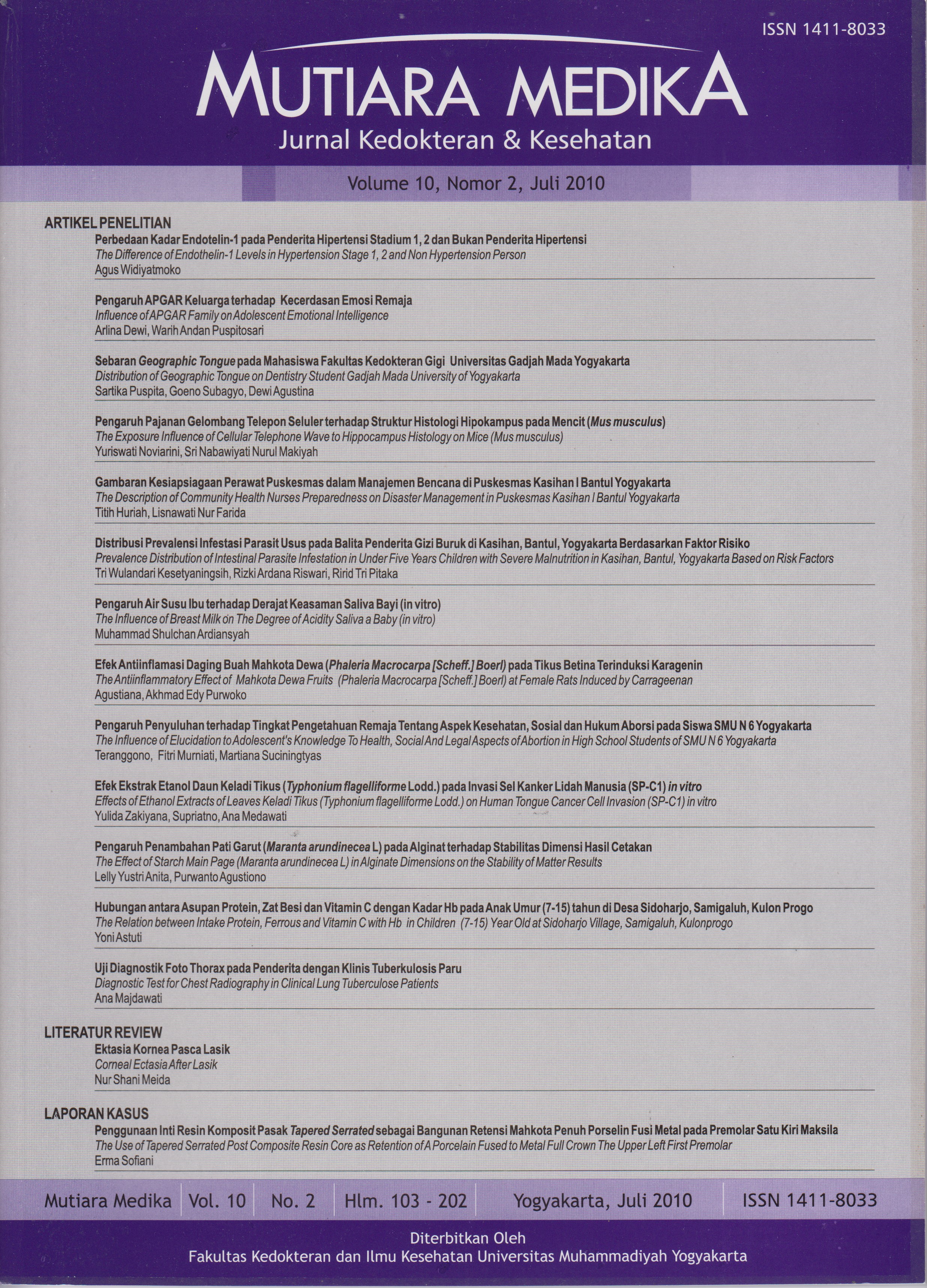Pengaruh APGAR Keluarga terhadap Kecerdasan Emosi Remaja
DOI:
https://doi.org/10.18196/mmjkk.v10i2.1571Keywords:
kecerdasan emosi, APGAR keluarga, remaja, emotional intelligence, family APGAR, adolescentAbstract
Emotional intelligence (EQ) contributed 80% in determining one ’s success. EQ was developed in 3 containers, namely: family, school and society, and experts agree that keluargalah have great influence on the development anak.Untuk, it is necessary to find whether the relationship between healthy functioning in the family (Apgar family) with adolescent emotional intelligence in family. This study aims to determine whether or not there any healthy relationship between family junction with emotional intelligence in adolescents in the family. Observational study conducted by the research design of cross-sectional survey. Samples were selected by simple random sampling from the population at SMU Negeri 1 Bantul Poor. Research instruments for assessing emotional intelligence using the instrument Baron Emotional Quotient Inventory Version andfamily function assessment using the Family Apgar instrument of Gabriel Smilkstein, which has been translated. Data analysis to determine relations between the two variables above using Pearson test. Statistical analysis showed that the Apgar Family related/correlated (r = 0.460) was significant (p <0.05) with adolescent emotional intelligence in the family. Concluded that there is a significant relationship between Apgar Families with teenagers Emotional Intelligence.
Kecerdasan emosi (EQ) menyumbang 80% dalam menentukan keberhasilan seseorang. Kecerdasan emosi dikembangkan dalam 3 wadah, yaitu : keluarga, sekolah dan masyarakat, dan para ahli sepakat bahwa keluargalah yang sangat berpengaruh terhadap perkembangan anak.Untuk itu, perlu dicari hubungan antara sehat tidaknya fungsi di dalam keluarga (APGAR keluarga) dengan kecerdasan emosi remaja di dalam keluarga tersebut. Penelitian ini bertujuan untuk mengetahui adakah hubungan antara sehat tidaknya fungsi keluarga dengan kecerdasan emosi pada remaja di keluarga tersebut. Penelitian dilakukan secara observasional dengan rancangan penelitian cross-sectional. Sampel penelitian dipilih secara simple random sampling dari populasi di SMU Negeri 1 Kasihan Bantul. Instrumen penelitian untuk menilai kecerdasan emosi menggunakan BarOn Emotional Quotient Inventory Version dan penilaian fungsi keluarga menggunakan instrumen Family APGAR dari Gabriel Smilkstein, yang telah dialihbahasakan. Analisis data untuk mengetahui hubungan antara kedua variabel di atas menggunakan uji Pearson. Hasil analisis statistik menunjukkan bahwa APGAR Keluarga mempunyai hubungan/ korelasi (r=0,460) yang bermakna (p<0,05) dengan kecerdasan emosi remaja di keluarga tersebut. Disimpulkan bahwa terdapat hubungan bermakna antara APGAR Keluarga dengan Kecerdasan Emosi remaja.
References
Goleman, D. 1995. Kecerdasan Emosional. PT Gramedia Pustaka Utama. Jakarta.
Patton, P. 2002. EQ-Pengembangan Sukses Lebih Bermakna. Mitra Media Publisher.
Adiningsih, N.U. 2001. Pembelajaran Anak oleh Orangtua. Dalam Media Indonesia, 2 Mei 2001. Jakarta.
Bluestein, D. & Rutledge, C. 1993. "Family Relationships and Depressive Symptom Preceding Induced Abortion” . Family Practice Research Journal, 13.
Gardner, W., Nutting, P.A., Kelleher, K. J., Werner, J.J., Farley, T., Stewart., L. , Hartsell M., Orzano, A.J. 2001.”Does the Family APGAR Effectively Measure Family Functioning?” Journal of Family Practice,Jan.
Langford, D. 2001. Family Assesment Assignment. NURS621 Families & Health.http://personal.uncc.edu/ drlangfo/nurs6210/familyassesment. htm
Sastroasmoro, S., Ismael, S. 2002. Dasar-dasar Metodologi Penelitian Klinis. Edisi ke-2. CV Sagung Seto. Jakarta.
Bar-On, R., and Parker, J.D.A. 2000. BarOn Emotional Quotient Inventory: Youth Version (EQ-i:YV): Technical manual. Multi-Health Systems. Toronto, Canada.
Bar-On, R. 1997. BarOn Emotional Quotient Inventory (EQ-i): A Test of Emotional Intelligence. Multi-Health Systems. Toronto, Canada
Sukardiansyah. 2004. Hubungan Kecerdasan Emosi Dengan Kecemasan Pada Siswa SMU. Tesis. Universitas Gadjah Mada. Yogyakarta.
Compan, E., Moreno, J., Ruiz, M.T., Pascual, E. 2002.”Doing Things Together: Adolescent Health and Family Rituals”. Journal of Epidemiology and Community Health. 56 : 89-94.
Tendean, E.S.B. 2001. Kecerdasan Emosional Ditinjau dari Pola Asuh Demokratis dan Gaya Kepemimpinan Demokratis dalam Proses Belajar Mengajar. Tesis. Fakultas Psikologi UGM. Yogyakarta.
Walgito, B. 1991. Hubungan Antara Persepsi Mengenai Sikap Orang Tua dengan Harga Diri Para Siswa SMU di Propinsi Jawa Tengah. Disertasi. Universitas Gadjah Mada. Yogyakarta.
Reeves,A. 2005. "Emotional Intelligence: Recognizing and Regulating Emotions”. AAOHN Journal, Apr, 53; Health and Medical Complete pg 172
Downloads
Published
Issue
Section
License
Copyright
Authors retain copyright and grant Mutiara Medika: Jurnal Kedokteran dan Kesehatan (MMJKK) the right of first publication with the work simultaneously licensed under an Attribution 4.0 International (CC BY 4.0) that allows others to remix, adapt and build upon the work with an acknowledgment of the work's authorship and of the initial publication in Mutiara Medika: Jurnal Kedokteran dan Kesehatan (MMJKK).
Authors are permitted to copy and redistribute the journal's published version of the work (e.g., post it to an institutional repository or publish it in a book), with an acknowledgment of its initial publication in Mutiara Medika: Jurnal Kedokteran dan Kesehatan (MMJKK).
License
Articles published in the Mutiara Medika: Jurnal Kedokteran dan Kesehatan (MMJKK) are licensed under an Attribution 4.0 International (CC BY 4.0) license. You are free to:
- Share — copy and redistribute the material in any medium or format.
- Adapt — remix, transform, and build upon the material for any purpose, even commercially.
This license is acceptable for Free Cultural Works. The licensor cannot revoke these freedoms as long as you follow the license terms. Under the following terms:
Attribution — You must give appropriate credit, provide a link to the license, and indicate if changes were made. You may do so in any reasonable manner, but not in any way that suggests the licensor endorses you or your use.
- No additional restrictions — You may not apply legal terms or technological measures that legally restrict others from doing anything the license permits.



